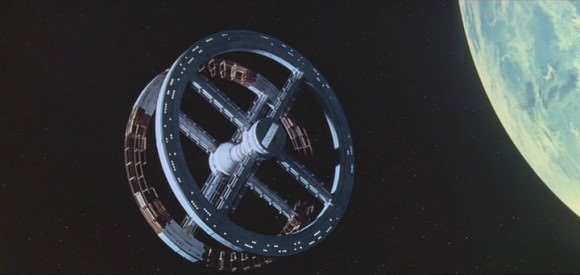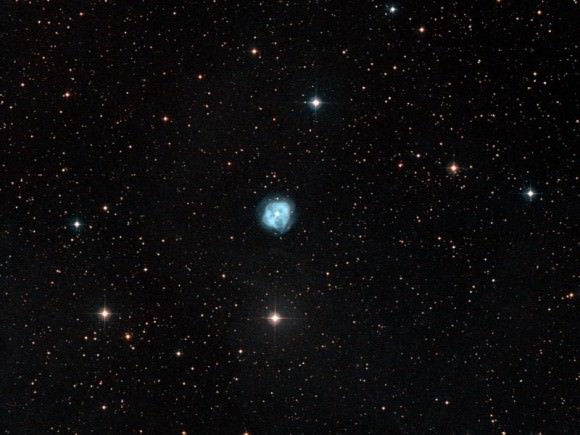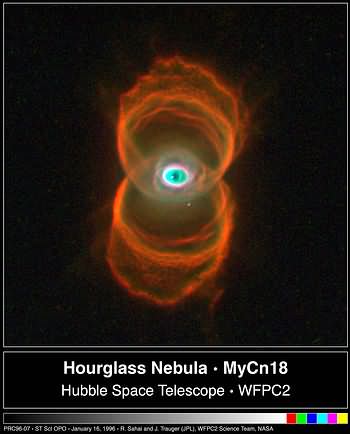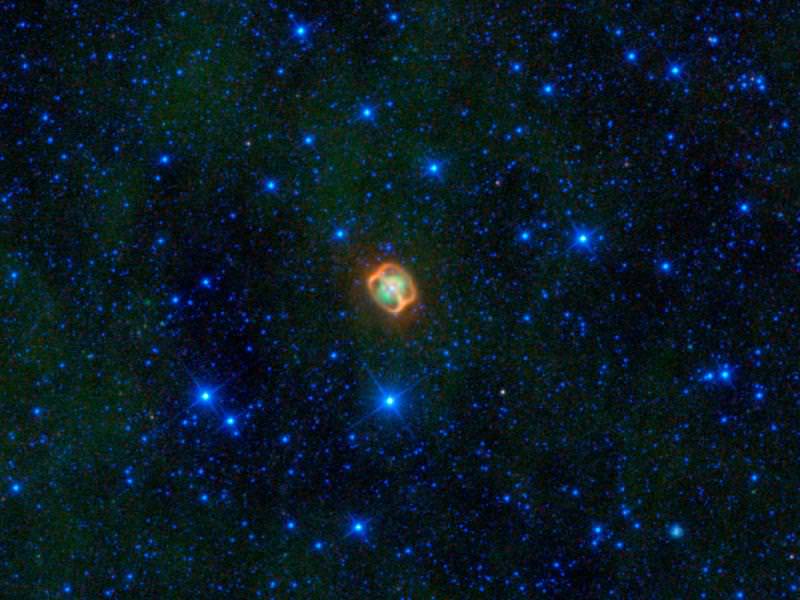[/caption]
It’s not like we’ve never seen the planetary nebula NGC 1514 before, but we’ve never seen it though WISE’s infrared eyes, until now. And in a stunning surprise, cylindrical rings appear to be encircling the dying star, like a neon-lit carousel, or perhaps like rolling tire surrounding a glowing blob. “I just happened to look up one of my favorite objects in our WISE catalogue and was shocked to see these odd rings,” said Michael Ressler, a member of the WISE science team at JPL. “This object has been studied for more than 200 years, but WISE shows us it still has surprises.

At first glance the rings look like the double-ringed space station in the movie 2001: A Space Odyssey. (Too bad the Bad Astronomer beat me to that likeness. He also compared it to a tuna can.)
Other people see different things in this image.
“I am reminded of the jellyfish exhibition at the Monterey Bay Aquarium — beautiful things floating in water, except this one is in space,” said Edward (Ned) Wright, the principal investigator of the WISE mission at UCLA, and a co-author of a paper on the findings, reported in the Astronomical Journal.
WISE was able to spot the rings for the first time because their dust is being heated and glows with the infrared light that WISE can detect. In visible-light images, the rings are hidden from view, overwhelmed by the brightly fluorescing clouds of gas.
Here’s what NGC 1514 looks like in visible light from a ground observatory:

The object is actually a pair of stars, seen as a single dot at the center of the blue orb. One star is a dying giant somewhat heavier and hotter than our sun, and the other was an even larger star that has now contracted into a dense body called a white dwarf. As the giant star ages, it sheds some its outer layers of material. An inner shell of ejected material is seen in bright, light blues. An outer shell can also be seen in more translucent shades of blue.
This planetary nebula is also called the “Crystal Ball” nebula, and Ressler said although NGC 1514’s structure looks unique, is probably similar in overall geometry to other hour-glass nebulae, such as the Engraved Hourglass Nebula.

The structure looks different in WISE’s view because the rings are detectable only by their heat; they do not fluoresce at visible wavelengths, as do the rings in the other objects.
The WISE science team says that more oddballs like NGC 1514 are sure to turn up in the plethora of WISE data — the first batch of which will be released to the astronomical community in spring 2011.
Source: JPL


Sir William Herschel discovered NGC 1514 on 13th November 1790.
It remains one of the most important finds, because it helped formulated and forge his general hypothesis about these unusual types of nebulae. Herschel correctly postulated that some nebulae did not always consist of minute stars, which he almost mystically described as some; “…shining fluid of a nature totally unknown to us.”
Wonder what he’d think if he saw the WISE image?
Observationally i’ve found;
NGC 1514 is readily visible under dark skies using 10.5cm. Some other sources though have claimed this is harder to see in apertures below 20cm. For me, it is both bright and quite easy to find. Telescopically, it looks like a large faint slightly ovoid halo surrounding the fairly bright central 9.5 mag. star, that is best seen in low to medium magnifications. In 20cm, the light from the gossamer nebulosity is fairly even, but using averted vision sees some brighter portions roughly diagonally across the field. Any larger telescope above 30cm, will see this large planetary has very smooth well defined envelope that is not exactly circular, with the brighter areas within the nebulosity being more prominent; especially east of the central star. Observers will find using an O-III filter will respond amazingly, revealing more than its visual washed out and non-descriptive nebulosity.
The just pre-published arXiv article is; The Discovery of Infrared Rings in the Planetary Nebula NGC 1514 During the WISE All-Sky Survey Ressler, M.E. et.al.
The introduction is particular (and unusually) novice/ amateur friendly. A much better close-up of the WISE image appear in Figure 2, including three separate colour images — Image d. is the most revealing.
As to this ring structure, this paper importantly describes;
They go on to say;
Yet the most important statement (not stated in Nancy’s article here) appears in the overall conclusion;
Sorry. The first quote above has “??”. This should be the character of arcsec (or as in the paper, the abbreviated — ″ I.e. 41″, 173″ and 177&8243;.
Incidentally, the given ring tilt is given in degrees.
INCREDIBLE!
Dang… it almost looks ‘manufactured’…